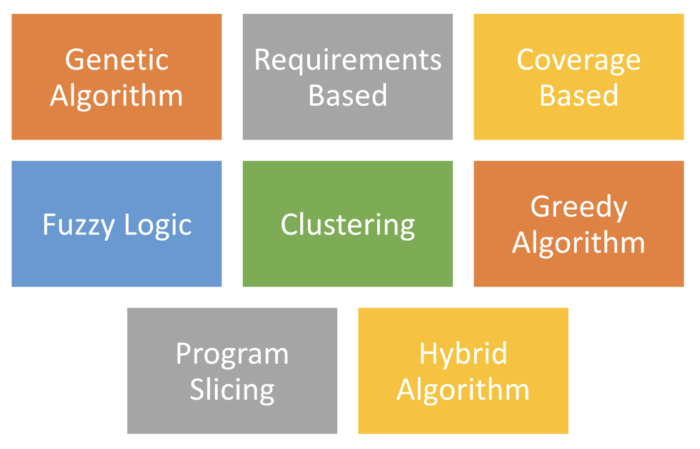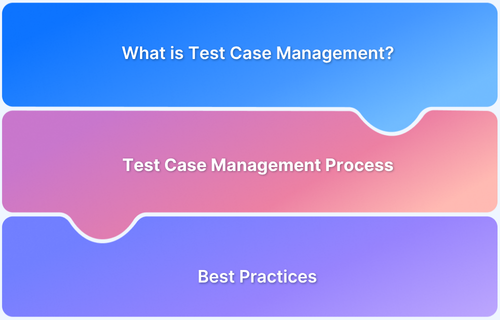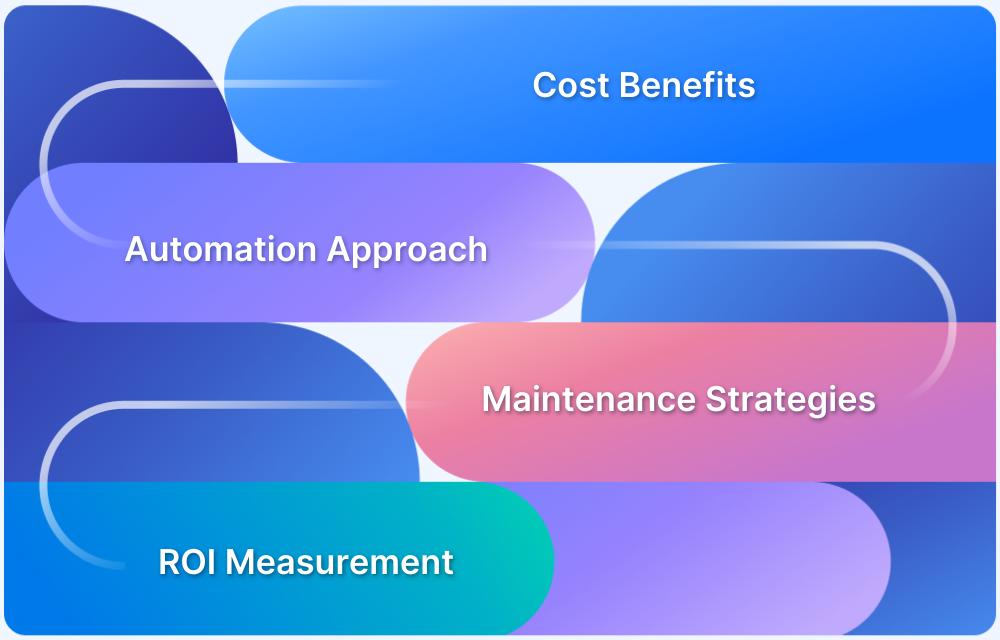Software Quality can be assured by going through the Software Testing process of the Software Development Life Cycle (SDLC). It is a critical and most expensive phase of the SDLC. All organizations desire to have their software tested thoroughly. But due to the different resource constraints, it is impractical to test exhaustively.
A large number of test suites are generated using Automation Tools. But the real problem is selecting a subset of test cases that are crucial to validate the System Under Test (SUT).
Overview
Test Case Reduction Techniques
- Requirement Based: Generate test cases based on requirements and reduce redundancy using greedy algorithms and dynamic domain reduction (DDR).
- Coverage Based: Focus on maximizing path coverage while filtering test cases using Case Base Reasoning (CBR) for efficient fault detection.
- Genetic Algorithm (GA): Use evolutionary algorithms to optimize test suites based on fitness values like coverage and runtime.
- Clustering: Group similar test cases using data mining techniques to reduce the suite size and improve efficiency.
- Greedy Algorithm: Select test cases that satisfy the most unsatisfied requirements, repeatedly reducing the suite size.
- Fuzzy Logic: Optimize test suites with human-like judgment using fuzzy logic, often combined with genetic or swarm algorithms for multi-objective optimization.
- Program Slicing: Focus on specific properties of the program to reduce test cases, using static, dynamic, or relevant slicing techniques.
- Hybrid Algorithm: Combine genetic and greedy algorithms to optimize test suites, balancing multiple objectives like fault detection and execution time.
This problem can be best solved by Test Case Reduction and Test Case Prioritization techniques at a small cost. These techniques have proved to improve the effectiveness of testing significantly.
What is Test Case Reduction?
Test Case Reduction, as the name suggests, is the process of cutting away all the code that is irrelevant to the bug and generating a smaller program or code that still induces the bug. This helps in reducing the cost of executing, validating, and managing test cases or test suites for the Development team.
Generic steps followed for reducing test cases can be:
- Write test cases manually or through automated tools.
- For each test case, build the coverage and data sets.
- Apply the proposed test case reduction technique and remove unwanted test cases.
- Analyze the effectiveness of the Test Case Reduction technique.
Read More: How do you ensure maximum test coverage?
Why is Test Case Reduction important?
Test Case Reduction is important because it:
- Reduces the execution time for large and complex programs.
- Avoids flaky tests, which are one of the most critical problems in testing software at the Google scale.
- Improves fault localization.
- It helps with Future-proof testing.
- It helps in creating new tests from existing ones.
- It helps in adapting software to environments with fewer resources.
- It provides an alternative way to fuzz.
- It is useful for core cybersecurity tasks like symbolic execution, bug triage, etc.
Test Case Reduction Techniques
Following are the techniques to reduce the number of test cases in any given test suite to make your life easier:

The main purpose of test suite reduction is to satisfy all the testing requirements with a minimum number of test cases. One such way is to generate test cases based on requirements by Requirement Optimization.
All the test cases of each testing requirement are generated, and then the greedy algorithm is applied to the constructed test suites for reduction. The redundancy in test suites and size can be reduced using model-checker-based techniques to create test cases. The requirement optimization is good when dealing with a finite Boolean expression that classifies the requirements as true or false test cases.
In order to maintain the effectiveness of fault localization, a technique called dynamic domain reduction (DDR) is also used, which helps in keeping the system free from errors at the same time, keeping the efficiency by reducing the number of test cases. DDR is good when dealing with arrays, loops, and expressions.
The third one is the Ping Pong technique which uses a heuristic technique to reorder the test cases that provides a good but not optimal solution. It takes requirements from natural language.
2. Coverage Based
The main purpose of the Coverage-based reduction technique is to ensure that the maximum number of paths of a given program is executed. Fault detection preservation is an important aspect of test case reduction in Regression testing.
This is done with the help of CBR (Case Base Reasoning). CBR has three classifications, namely, Case, Auxiliary, and Pivotal.
- Case-based searches for the most similar problems to solve problems, i.e., a memory.
- An Auxiliary-based case can be deleted without affecting competence, but it does affect the system’s efficiency.
- A Pivotal-based case has a direct impact on the system competence if deleted.
CBR uses three methods for test case reduction:
- Test Case Complexity for Filtering (TCCF): Coverage set, Reachability set, and Auxiliary set are determined, and the complexity for each test case is calculated. The test case with the minimum complexity value is removed.
- Test Case Impact for Filtering (TCIF): The impact of the test cases is checked based on their ability to detect faults when these test cases are removed.
- Path Coverage for Filtering (PCF): It is a structure testing that chooses test cases that determine the path to be taken within the program structure.
3. Genetic Algorithm (GA)
It is a computational intelligence-based approach used as a solution for various test case reduction problems like Evolutionary Computation.
For example, a Genetic Algorithm was proposed that builds the initial population based on the test history. The following things were done:
- Fitness value depending on the coverage and runtime of test cases was calculated.
- Only the tests that fit were allowed to be in the reduced suite.
- This process is repeated until an optimized test suite is found.
The results showed that the proposed test suite reduction technique was cost-effective and had generality.
One of the major advantages of this algorithm is that it helps in test case reduction along with a simultaneous decrease in the total run time. However, it fails when an examination of the fault detection capability along with other criteria is asked for.
4. Clustering
The Data Mining approach of Clustering techniques is used to reduce the test cases in the test suite and improve efficiency. With the help of Clustering, the program can be checked with any one of the Clustered test cases rather than the entire test cases produced by independent paths.
It is simply based on selecting the test cases based on coverage and distribution. The most common techniques include Construction algorithms, Graph theoretical algorithms, Optimization algorithms, and Hierarchical algorithms. They do produce a smaller set of test cases but with reduced fault detection ability.
5. Greedy Algorithm
It is one of the popular code–based reduction techniques and is applied to test suites obtained from Model-based techniques. It selects the test cases which satisfy the maximum number of unsatisfied requirements. This technique is repeated until all the test cases in the test suite lead to the production of a reduced test suite. This algorithm works on the basis of the relationship that exists between testing requirements and test cases.
An advantage of the Greedy algorithm is that it provides a significant reduction in the total number of test cases, but it involves a random selection of test cases in case of a tie situation occurs. It needs to be optimized in case of large-scale test suites.
6. Fuzzy Logic
Another way to perform the optimization of test suites is by using fuzzy logic. This is termed to be a safe technique as it helps in reducing the regression testing size along with the execution time. The level of testing used here is based on an objective function, which is quite similar to human judgment.
Genetic algorithm and Swarm optimization combined with fuzzy logic can be used to make optimizations in the test suite for multi-objective selection criteria. Some CI-based approaches are often used to achieve test suite optimization and test suite analysis for safe reduction, which can then be executed using control flow graphs.
These graphs are used for traversing test cases of optimal solutions. Often recommended, this method is considered to be safer than other methods for regression testing.
7. Program Slicing
It is a technique used to check a program over a specific property and build a slice set. This set consists of a set of statements effect to determine a statement, i.e., it is the output statement of a program based on some input values.
This technique helps to show the control flow for each test case in a program. There are three types of slicing techniques:
- Static Slicing
- Dynamic Slicing
- Relevant Slicing
Number of required test cases can be decreased using Slicing techniques thereby decreasing the time and cost of testing.
Did you know the ROI of your Test Automation? Check out using Calculating Test Automation ROI: A Guide
8. Hybrid Algorithm
This algorithm combines the efficient approximation of the genetic algorithm with the greedy approach to produce high-quality Pareto fronts in order to achieve multiple objectives. Here, the objective functions are considered as a mathematical description of the test criterion.
A cost-effective version of the Greedy algorithm is used for Statement coverage and Computational cost. For Fault detection, code coverage, fault coverage, and execution time are also considered for optimization.
Pros and Cons of the Test Case Reduction Techniques
Here’s a quick list of Pros and Cons of different Test Reduction Techniques that will help you decide which one to use when:
| Techniques | Pros | Cons |
|---|---|---|
| Requirement Based | Provides a good percentage of reduction in the redundancy of test cases. | Maybe time-consuming. Need more memory depending on how to represent the requirements. |
| Coverage Based | The rate of test case reduction is very high. It reduces time too. | Path coverage seems ineffective for large systems since it consumes time and cost. |
| Genetic Algorithm | The number of test cases is reduced along with the total execution time. | A little behind in the fault detection capability. |
| Clustering | Produces a small representative set of test cases. | Less fault detection capability. |
| Greedy Algorithm | Significant decrease in the number of test cases. | Involves random selection of test cases in case of a tie situation. |
| Fuzzy Logic | Safe technique. Size and execution time is reduced for regression testing. | Need more experiments and studies. |
| Program Slicing | The number of required test cases is reduced. Consequently, the cost and time of testing are decreased. | Need to be examined on the fault detection capability and larger data. |
| Hybrid Algorithm | Provide significant reduction in the number of test cases and multi-objective optimization. | Highly Complex. |
Conclusion
Undoubtedly, Test-case reduction is a powerful tool to have in your testing utility belt. Knowing all the things that test-case reduction can do, you can improve the effectiveness of your tests and make debugging a much more pleasant task. It is best to minimize the cost, effort, and time during the Software Testing phase. However, it is important to use the aptest test case reduction technique to reap maximum benefits from it.
No matter how you reduce your test cases, it is essential to test them under real user conditions to ensure better accuracy in the tests. By testing on real device cloud, like BrowserStack, you can increase your test coverage by getting access to 3000+ real browser-device combinations. This helps in ensuring faster and more accurate testing of the software. Run your Regression Tests using cloud Selenium Grid for parallel testing across different browser-device combinations for a seamless and consistent user experience.






